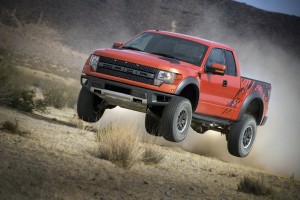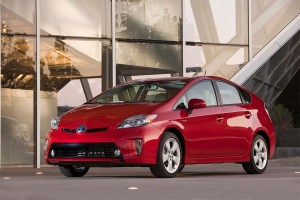
Low-mileage trucks like the Ford Raptor have regained momentum as the housing market and overall economy revive.
If you’re focused on the revival of the U.S. car market and the profitability of automotive manufacturers, then the recent surge in sales of full-size pickups is great news. If your focus is fuel economy, well, the headlines might come as a disappointment.
That’s because the upturn in the truck market is driving down the fuel economy of the typical vehicle sold in the U.S., according to the latest report from the University of Michigan Transportation Research Institute, or UMTRI.
The gap isn’t much, a decline of a tenth of a mile per gallon in June — to 24.7 mpg — but it is a rare reversal of the upward trend that had seen fuel economy so far increase 1.1 mpg during the 2013 model-year.

While Toyota Prius sales have slid, demand for small cars overall has minimized the fuel economy downturn.
This slight reduction likely reflects the recent drop in the price of gasoline, Michael Sivak, UMTRI’s Director of Sustainable Worldwide Transportation.
Pickup sales jumped 23.9% last month compared to year-ago levels, while the overall U.S. new vehicle market gained just 9.2%. Data-tracking service Autodata also notes that for the first half of 2013, pickup sales were up 21.7%, nearly triple the industry’s overall 7.7% gain.
The burst in demand means that there are more 13 mpg Ford F-150 Raptors and 16 mpg Ram 1500s rolling out of dealer showrooms. Then again, the June industry sales numbers also showed a simultaneous burst of activity in the small car market, meaning more 38 mpg Nissan Altimas and 41 mpg Ford Fiestas.
(2014 Chevrolet Corvette Stingray to get up to 30 mpg. Click Here for the story.)
The result is that fuel economy has generally remained stable even with the revival in truck sales that appear to reflect an improvement in the housing industry and the U.S. economy overall.
In fact, fuel economy has become the single biggest factor for American motorists, whether they are driving full-size pickups of minicars. In fact, some of the biggest improvements in mileage are coming at the large end of the vehicle spectrum.
Chrysler will launch a new diesel version of its Ram 1500 for the 2014 model-year expected to yield slightly less than the 30 mpg the same 3.0-liter turbodiesel delivers in the 2014 Jeep Grand Cherokee. Ford, meanwhile, has seen a surge in demand for its two V-6 versions of the F-Series pickups, a segment traditionally dominated by gas-swilling V-8s.
(For a first look at the 2014 Ram 1500 turbodiesel, Click Here.)
Nonetheless, the recent, sharp decline in fuel prices – which averaged $3.474 across the U.S. on Monday, down 15.9 cents from a month ago, according to AAA – have had an impact on the market.
Premium-priced hybrids, in particular, are struggling. Nowhere is that more obvious than with the so-called Toyota Prius whose sales fell 5.1% during the first half of the year, even as the Japanese maker’s overall American volume jumped 6%.
(Flood of new hybrids takes aim at Toyota Prius. Click Here for more.)
Though fuel economy might have suffered a minor setback in June, the UMTRI numbers generally appear moving in a positive direction. So are the results of the organization’s Eco-Driving Index, which estimates the average monthly emissions of greenhouse gases generated by an individual U.S. driver.
The figure for April, the latest month available, stood at 0.82 (the lower the value the better). This indicates an improvement of 18% since October 2007 when the index was created. The EDI takes into account both the fuel used per distance driven and the amount of driving done by a vehicle’s owner.
Paul A. Eisenstein contributed to this report.

This is precisely why car makers are trying to sell EVs and hybrids. There simply is no way to meet the absurd 54.5 mpg CAFE requirement that is looming large.